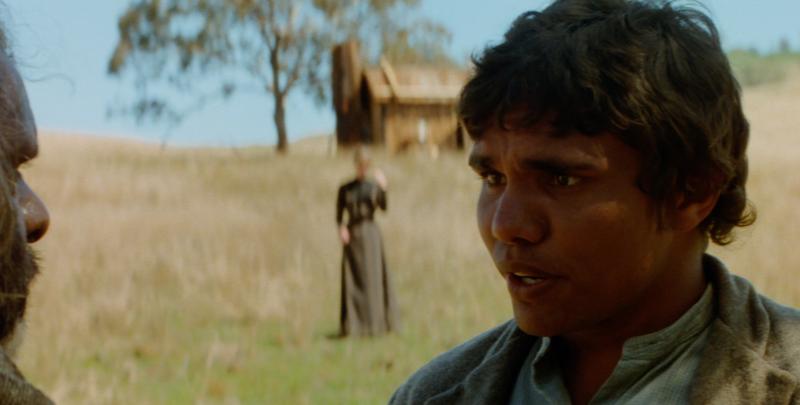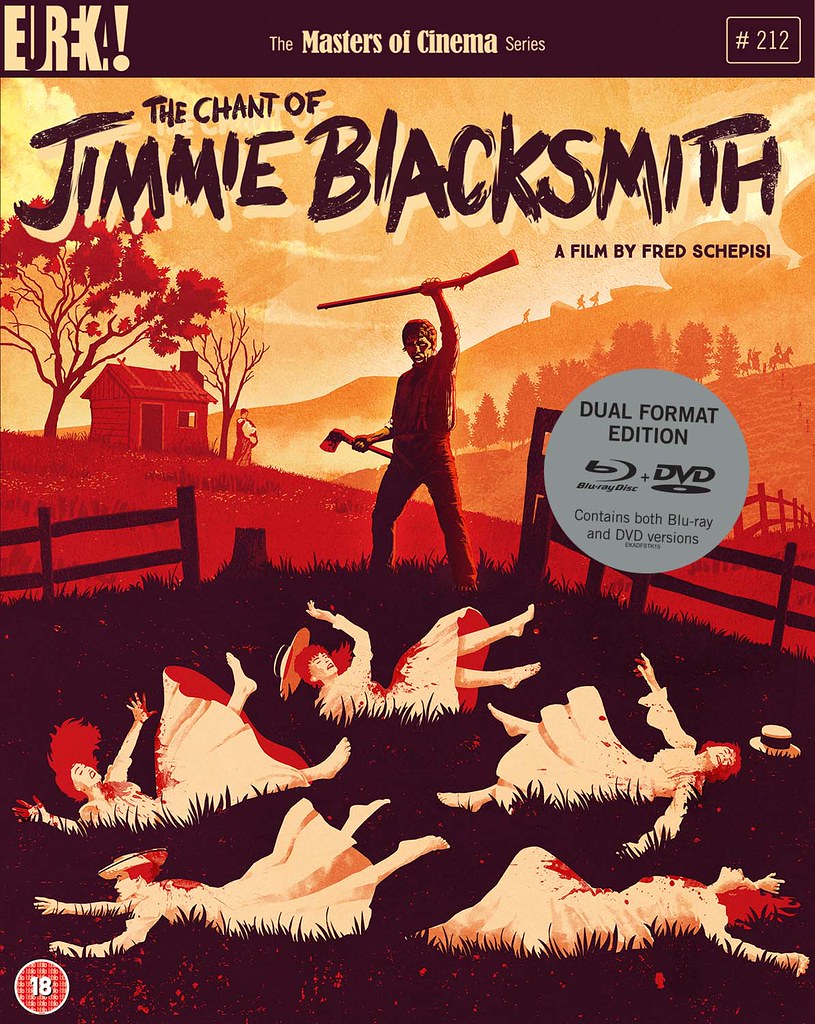DVD/Blu-ray: The Chant of Jimmie Blacksmith | reviews, news & interviews
DVD/Blu-ray: The Chant of Jimmie Blacksmith
DVD/Blu-ray: The Chant of Jimmie Blacksmith
Mixed-race heritage condemns a striving youth in 1900 Australia

Fred Schepisi’s The Chant of Jimmie Blacksmith (1978) was the Australian New Wave film that most rigorously confronted the cataclysmic effect of British and Irish colonisation on the country’s Abor
Schepisi adapted it from Thomas Keneally’s 1972 novel, which looked beyond the Aboriginal genocide to the tragedy of attempted black assimilation in the whitefellas’ culture. Jimmie was based by Keneally on Jimmy Governor, a farm fencer born to an Aboriginal father and a half-white mother in New South Wales in 1875. Governor and a fellow Aborigine worker, Jacky Underwood, massacred four white women and a boy in 1900 for abusing Governor and his white teenage wife, Ethel; the fugitives carried out four more revenge killings before they were captured. Governor and Underwood were hung in January 1901; Ethel gave birth to her and Governor’s second child after his death.
 The Chant of Jimmie Blacksmith, which depicts most of these events, makes a powerful case that Jimmie (Tommy Lewis), a well-meaning and ambitious half-white blackfella, is a victim of his begetting: male pioneers' sexual predation on “gins” (Aborigine women) which was endemic in the colony. Raised by a punitive white clergyman (Jack Thompson) and his wife, Jimmie is cut off from his tribe and consistently cheated by the Scottish and Irish landowners who hire him.
The Chant of Jimmie Blacksmith, which depicts most of these events, makes a powerful case that Jimmie (Tommy Lewis), a well-meaning and ambitious half-white blackfella, is a victim of his begetting: male pioneers' sexual predation on “gins” (Aborigine women) which was endemic in the colony. Raised by a punitive white clergyman (Jack Thompson) and his wife, Jimmie is cut off from his tribe and consistently cheated by the Scottish and Irish landowners who hire him.
He works briefly for a vicious policeman (Ray Barrett) whose outrages include raping and murdering a black jailbird who was once Jimmie's friend. When Jimmie’s white wife Gilda (Angela Punch) bears an all-white child, he accepts it as his own but fears that he will be rejected later. The white women who helped deliver the baby implore Gilda to leave Jimmie; they’re among those he spontaneously kills when he’s exploited one time too many.
The movie’s intricate mise-en-scéne reflects Jimmie’s alienation from his ancestral land and his sense of entrapment indoors. Schepisi’s regular cinematographer Ian Baker shot much of the film in a near-anthropological style. That it now seems visually dated scarcely detracts from its historical significance. The music cues are awful, some of the staging and acting crude. But Bryan Brown is fine in a small part as a mouthy bloke – and the handsome, charismatic Lewis excels in the lead role.
In his late teens when the film was made, Tommy Lewis (or Tom E Lewis), was Balang TE Lewis, who became a prolific actor, musician and champion of Aboriginal traditions; he died suddenly at 59 in May 2018. His humble on-camera testimony in this dual format disc’s extras (recorded in 2008 and issued with previous releases) is a compelling reason to own it.
Lewis's life wasn't as brutal as Jimmie Blacksmith’s, but there were clear echoes.The son of a Welshman and a Murrungun woman, he talks hauntingly about the early deaths of many of his Aborigine friends from alcoholism – a theme in the movie – and discusses his own battles with it. Mirthfully, he describes how he just about refrained from using violence against whites who suspected him of kidnapping the little blonde girl he used to carry on his shoulders: she was his daughter. Among career interviews with Schepisi and Baker and other featurettes, Lewis’s reminiscences are the stuff of anguish and resistance. He carried a banner for all the Jimmies.
rating
Share this article
The future of Arts Journalism
You can stop theartsdesk.com closing!
We urgently need financing to survive. Our fundraising drive has thus far raised £49,000 but we need to reach £100,000 or we will be forced to close. Please contribute here: https://gofund.me/c3f6033d
And if you can forward this information to anyone who might assist, we’d be grateful.

Subscribe to theartsdesk.com
Thank you for continuing to read our work on theartsdesk.com. For unlimited access to every article in its entirety, including our archive of more than 15,000 pieces, we're asking for £5 per month or £40 per year. We feel it's a very good deal, and hope you do too.
To take a subscription now simply click here.
And if you're looking for that extra gift for a friend or family member, why not treat them to a theartsdesk.com gift subscription?
more Film
 Bugonia review - Yorgos Lanthimos on aliens, bees and conspiracy theories
Emma Stone and Jesse Plemons excel in a marvellously deranged black comedy
Bugonia review - Yorgos Lanthimos on aliens, bees and conspiracy theories
Emma Stone and Jesse Plemons excel in a marvellously deranged black comedy
 theartsdesk Q&A: director Kelly Reichardt on 'The Mastermind' and reliving the 1970s
The independent filmmaker discusses her intimate heist movie
theartsdesk Q&A: director Kelly Reichardt on 'The Mastermind' and reliving the 1970s
The independent filmmaker discusses her intimate heist movie
 Blu-ray: Wendy and Lucy
Down-and-out in rural Oregon: Kelly Reichardt's third feature packs a huge punch
Blu-ray: Wendy and Lucy
Down-and-out in rural Oregon: Kelly Reichardt's third feature packs a huge punch
 The Mastermind review - another slim but nourishing slice of Americana from Kelly Reichardt
Josh O'Connor is perfect casting as a cocky middle-class American adrift in the 1970s
The Mastermind review - another slim but nourishing slice of Americana from Kelly Reichardt
Josh O'Connor is perfect casting as a cocky middle-class American adrift in the 1970s
 Springsteen: Deliver Me From Nowhere review - the story of the Boss who isn't boss of his own head
A brooding trip on the Bruce Springsteen highway of hard knocks
Springsteen: Deliver Me From Nowhere review - the story of the Boss who isn't boss of his own head
A brooding trip on the Bruce Springsteen highway of hard knocks
 The Perfect Neighbor, Netflix review - Florida found-footage documentary is a harrowing watch
Sundance winner chronicles a death that should have been prevented
The Perfect Neighbor, Netflix review - Florida found-footage documentary is a harrowing watch
Sundance winner chronicles a death that should have been prevented
 Blu-ray: Le Quai des Brumes
Love twinkles in the gloom of Marcel Carné’s fogbound French poetic realist classic
Blu-ray: Le Quai des Brumes
Love twinkles in the gloom of Marcel Carné’s fogbound French poetic realist classic
 Frankenstein review - the Prometheus of the charnel house
Guillermo del Toro is fitfully inspired, but often lost in long-held ambitions
Frankenstein review - the Prometheus of the charnel house
Guillermo del Toro is fitfully inspired, but often lost in long-held ambitions
 London Film Festival 2025 - a Korean masterclass in black comedy and a Camus classic effectively realised
New films from Park Chan-wook, Gianfranco Rosi, François Ozon, Ildikó Enyedi and more
London Film Festival 2025 - a Korean masterclass in black comedy and a Camus classic effectively realised
New films from Park Chan-wook, Gianfranco Rosi, François Ozon, Ildikó Enyedi and more
 After the Hunt review - muddled #MeToo provocation
Julia Roberts excels despite misfiring drama
After the Hunt review - muddled #MeToo provocation
Julia Roberts excels despite misfiring drama
 London Film Festival 2025 - Bradley Cooper channels John Bishop, the Boss goes to Nebraska, and a French pandemic
... not to mention Kristen Stewart's directing debut and a punchy prison drama
London Film Festival 2025 - Bradley Cooper channels John Bishop, the Boss goes to Nebraska, and a French pandemic
... not to mention Kristen Stewart's directing debut and a punchy prison drama
 Ballad of a Small Player review - Colin Farrell's all in as a gambler down on his luck
Conclave director Edward Berger swaps the Vatican for Asia's sin city
Ballad of a Small Player review - Colin Farrell's all in as a gambler down on his luck
Conclave director Edward Berger swaps the Vatican for Asia's sin city

Add comment